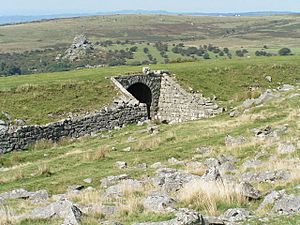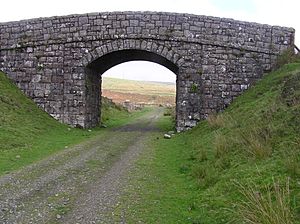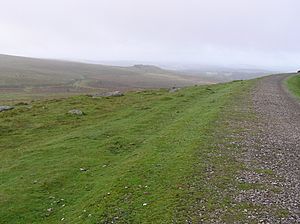Princetown Railway facts for kids
The Princetown Railway was a special train line in Devon, England. It was about 10 miles long and had only one track. This line connected Yelverton to Princetown. Along the way, it stopped at four smaller stations: Dousland, Burrator and Sheepstor Halt, Ingra Tor Halt, and King Tor Halt. The railway closed down in 1956. Today, the old track is a popular path for walking and cycling.
Contents
How the Railway Started
A very old railway, the Plymouth and Dartmoor Railway, opened in 1823. It linked Princetown to a port near Plymouth. This older line was built to help farms grow in the moor. However, it mostly carried heavy granite stones from quarries near Princetown. Horses pulled the wagons on this line, and it did not carry people.
Later, in 1852, people wanted to build a new railway. This new line, called the South Devon and Tavistock Railway (SD&TR), would connect Tavistock to the main railway near Plymouth. They also thought about building a branch line to Princetown. This branch would go to the large prison there, HM Prison Dartmoor. But this plan did not happen right away. The SD&TR line opened in 1859. It went from Marsh Mills to Tavistock, passing through a tunnel near Yelverton.
In 1874, another group tried to build a branch line from Yelverton to Princetown. This idea also did not get enough support.
Finally, the Great Western Railway (GWR) took over the SD&TR line. The GWR decided to build the Princetown branch from Yelverton. They got permission from the government on August 13, 1878. A new company, the Princetown Railway, was formed. The GWR would run the trains and had a lot of control. Even though the GWR was involved, the line was built using the standard track width, which was different from some older lines.
The new line was about 10¼ miles long. It started at Yelverton and went all the way to Princetown. The company bought the upper part of the old Plymouth and Dartmoor Railway for £22,000. They used much of the old track's path. However, they had to make some changes. The old horse-drawn railway had very sharp turns. These turns had to be made smoother for the new, bigger trains.
The government helped pay for the railway's construction. There was also a plan to use prison workers to build it. But this idea was dropped because it was too difficult.
On July 7, 1883, an inspector checked the line. He found some problems and said it could not open yet. After the problems were fixed, he came back. The Princetown Railway officially opened on August 11, 1883, without a big ceremony.
How the Trains Ran
When the line first opened, passenger trains ran from Horrabridge to Princetown. This was because there was only a goods area at Yelverton. The inspector wanted a proper station at Yelverton or a bigger one at Horrabridge. For a while, Horrabridge was the main station for changing trains. But the GWR opened a new station at Yelverton on May 1, 1885. After that, the Princetown trains started and ended their journeys there.
The railway line went uphill almost all the way to Princetown. It also had many sharp curves. This made it hard for the train engines to pull the carriages.
When a train arrived at Yelverton from Princetown, passengers would get off. Then, the empty train would be pushed up a hill past a side track. The engine would move onto this side track. The carriages would then roll back down into the station platform, controlled by the guard.
The stations along the line were:
- Dousland station: This station had one platform.
- Burrator & Sheepstor Halt: This stop opened on February 4, 1924. It became popular for people who enjoyed walking, as Burrator reservoir is nearby.
- Ingra Tor Halt: This stop opened on March 2, 1936.
- King Tor Halt: This stop opened on April 2, 1928.
- Princetown: This was the very last stop on the line. It was very high up, about 1,373 feet above sea level.
At Princetown, there was a special turning platform for the engines. In the 1900s, the trains used on this line were mostly a type called the GWR 4400 Class. These trains often carried both passengers and goods.
What the Railway Carried
Most of the things carried on the railway were for HM Prison Dartmoor. This included people going to the prison, prison staff, and supplies. The line also carried granite from nearby quarries. Sometimes, there were special trains for tourists.
In 1924, the Burrator Platform was opened. This was for workers who were building and making the Burrator and Sheepstor Dams bigger.
After 1930, people going to the prison were mostly taken by a different route. This was because the Southern Railway line to Tavistock and a road connection were easier. However, during and just after World War 2, the Princetown line was used again for prison transport.
Two more small stops, King Tor and Ingra Tor, were opened in 1928 and 1936. These were added to help the railway compete with local bus services and to encourage more tourists to visit.
In 1949, trains ran from Yelverton to Princetown several times a day, Monday to Saturday. There were passenger trains and trains that carried both passengers and goods. There were also freight trains that carried only goods. These freight trains stopped at only a few places before going on to Horrabridge.
Who Owned the Railway
The Great Western Railway ran the Princetown line. But the Princetown Railway company owned it until January 1, 1922. On that date, the Princetown Railway joined with the GWR. Later, in 1948, the line became part of British Railways. The Princetown Railway line closed on March 3, 1956.
The Route Today
Today, the old railway track is a very popular place for walking across the moor. Much of the line is now part of the Dousland to Princetown Railway Track. It is a path for walking and a rough path for cycling.
Images for kids






